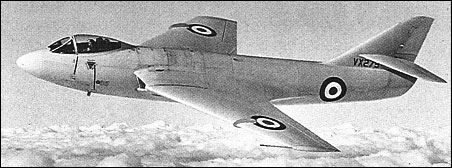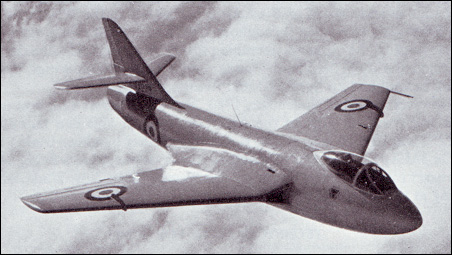|
| Developed as a result of Australian interest in an operational
fighter version of the P.1052 swept-wing research
aircraft, the P.1081 was a rebuild of the second
P.1052 incorporating a straight-through (as opposed to
bifurcated) jet pipe and a new all-swept tail. Non-availability
of the Rolls-Royce Tay turbojet proposed for installation
resulted in retention of the original 2268kg Nene R.N.2. With this power plant, the P.1081
was flown on 19 June 1950. Consideration was given to
building a second, fully representative prototype with a
four 20mm cannon armament and an afterburning Tay
engine, but, on 14 November 1950, further work on the
Australian project was cancelled. The sole P.1081 was
subsequently transferred to the RAE, but was destroyed
in an accident on 3 April 1951.
| WEIGHTS |
| Take-off weight | 6568 kg | 14480 lb |
| Empty weight | 5080 kg | 11200 lb |
| DIMENSIONS |
| Wingspan | 9.60 m | 32 ft 6 in |
| Length | 11.38 m | 37 ft 4 in |
| Height | 4.04 m | 13 ft 3 in |
| Wing area | 23.97 m2 | 258.01 sq ft |
| PERFORMANCE |
| Max. speed | 1119 km/h | 695 mph |
 | A three-view drawing (1670 x 1135) |
| Billy Pryce, e-mail, 27.07.2011 16:15 I find the over protracted development that finally led to the Hunter a bit sad in retrospect. The P1052 being used to investigate the low speed characteristics of swept wings when the F86 and MiG 15 were already in service strikes me as being a bit lethargic. Wasn't data already available from German research and the reciprocal technology agreements with the US? Why not just build a swept wing fighter and call it the Hunter?
Reading James Hamilton-Paterson's 'Empire of the Clouds' just now so I'm currently obsessed. reply | | John Mitchell, 10.08.2010 18:30 The plane mentioned by Mr. Simpson was not a P1081, it was it's successor the P1067 Hunter.
The plane, WB188, broke the world airspeed record off the South coast where Mr. Simpson saw it. I think that it was in 1953, I was a Hawker apprentice at the time and remember it well. The next time that I saw WB188, was during my National Service when I was posted to RAF Melksham in 1957 to find it serving as the "Gate Guardian". I felt very sad about that. Mr Simpson was correct about the pilot, Neville Duke. reply | | Sven, 15.12.2009 08:05 The pilot would be Neville Duke. The aircraft probably a Hunter. reply | | c. Simpson, e-mail, 14.12.2009 14:21 If I remember correctly as a young child I saw this plane break the sound barrier on the south coast of England off the town of Worthing. The aircraft flew a triangular course out to the mid channel and then flew west along the beach. The result was a number of broken windows in the hotels along the promenade. The pilot made several passes and I believe the pilots name was Neville _____? Having grown up around airfields and hearing planes coming and going it was unusual to see this plane coming with no sound until it was on you. I also remember that the pilot was very low and close to the beach. reply |
|
Do you have any comments?
|
| 
COMPANY
PROFILE
All the World's Rotorcraft
|








